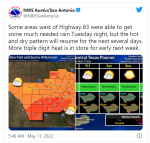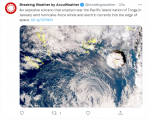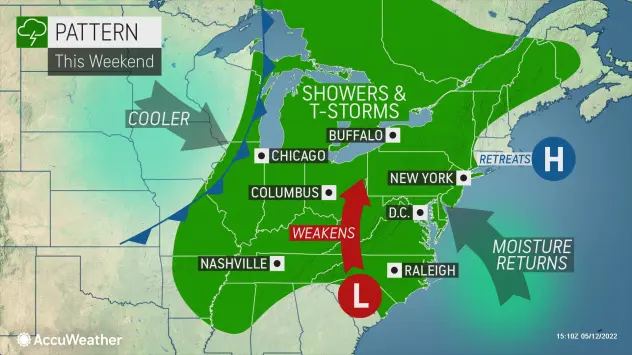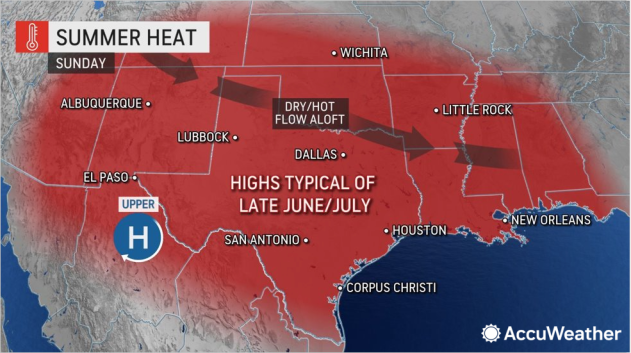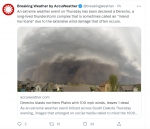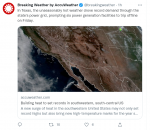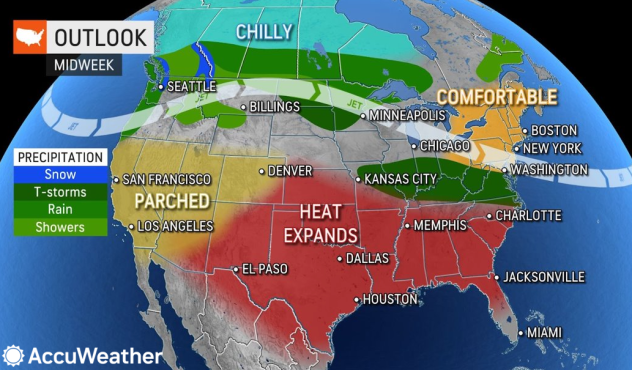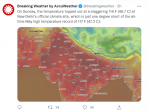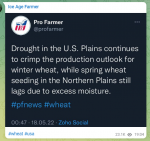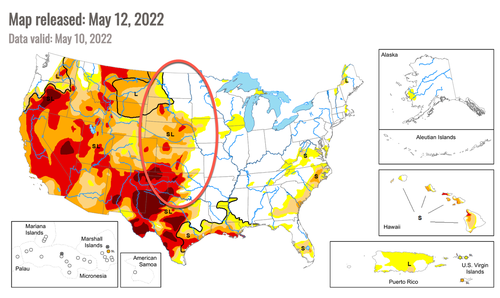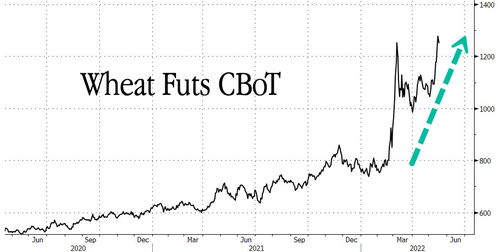Electroverse
Crop Loss Extreme Weather GSM
Canada Just Suffered Its Lowest Late-May Temperature Ever; U.S. Growing Woes Persist; Mexican Grapes Delayed Due To Cold; + Russia Snubs UN’s Grain-For-Fertilizer Plan
May 26, 2022 Cap Allon
Canada Just Suffered Its Lowest Late-May Temperature Ever
It’s been exceptionally cold in Northern Canada of late.
The far-northern territory of Nunavut has been busy busting records. On Wednesday, May 25 the mercury at Hall Beach plunged to a moose-hugging -22.2C (-8F), which, according to the official weather books, is a national record for this time of year.
Exceptionally cold in
#Nunavut for late May.
Today, Sanirajak/Hall Beach recorded a Tmin of -22.2C (windchill -34), which is at record level for this time of year anywhere in
#Canada.
Very cold also in the capital
#Iqaluit where it could be below -15C tomorrow.
#NUstorm pic.twitter.com/0qPlhHZmZI
— Thierry Goose (@ThierryGooseBC)
May 25, 2022
Worth noting, Canada’s record low for the month of
June stands at -20.6C (-5.1F), registered at the same location, Hall Beach; while the low for the entire Northern Hemisphere as a whole is the -22.2C (-8F) logged at Mys Sterlegova and Andreya Island (Russia).
Astonishingly, given this time of ‘terrifying terra firma broiling’
(aka global warming, aka climate change, aka the Great Reset), the Northern Hemisphere was just days away from tying its coldest June temperature in recorded history. And, given the outlook, I wouldn’t rule out this actually occurring next week as anomalous cold is set to persist in northern Nunavut through June 1.
U.S. Growing Woes Persist
Yesterday, May 25, was exceptionally cold across much of the United States.
Kansas and Oklahoma, for example, experienced daytime highs in the 50s, and, according to official data, many locales suffered temperatures not see at this time of year for more than century.
This
natural phenomenon –weather– is proving the final straw for many North American growers.
Brent Reed, a fifth generation Elkhart County farmer shares how unpredictable weather patterns, supply chain issues, and inflated overhead prices are heaping seemingly insurmountable pressure on his farm’s corn production this year.
Reed has four prior generations of farming knowledge, dating back to his great-great-grandfather, but the year 2022 is putting those ingrained skills and instincts to the test: as reported by
abc57.com, planting, growing and harvesting corn on the Reed farm will come with additional challenges that his lineage could have never prepared him for.
“I’ve never seen anything like this, and my dad’s never seen anything like this either,” said Reed re. the persistent spring cold. But the weather is just the first round of challenges for this year’s farming efforts. Record-high diesel prices, inflated input costs, and supply chain shortages have left farmers most-everywhere feeling stressed and watching profits shrink.
“Our fertilizer is doubled or more, our chemistry is double or triple of last year. So far we’ve been able to get everything, but there’s talk some places that they can’t get everything they want,” continued Reed, which leads him to worry for 2023: “Next year is the year we’re already thinking about. Our input prices went up since we purchased this year’s inputs. Can we get everything we need for next year?”
Spring planting has been seriously delayed across the U.S. this year. And while the struggle to get seeds into the ground is a major concern, input shortages are just as damaging: a global shortfall of fertilizers, herbicides and pesticides will see drastically reduced yields. It’s a recipe for disaster –low planting numbers + poor yields– yet TPTB seem hellbent on adding fuel to the fire, with
their culling of millions of poultry (due to ‘bird flu’), their schemes rewarding farmers for NOT growing crops, and
their Russian fertilizer sanctions (more on that later).
Mexican Grapes Delayed Due To Cold
Mexico’s grape season has seen a slower-than-expected start due to cold weather slowing the ripening process.
Marco Antonio Camou, president of a Sonora based local grape growers association, told
Diario de Hermosillo in mid-May that parts of the region had yet to see the warmer days needed to properly harvest the grapes.
“Usually, the beginning of May is when the harvest starts, and it depends much on the weather. Lately, nights have been cold, days have not been very warm, and this means that the grape ripening is delayed along with the harvest,” said Camou.
Despite the delays, however, the harvest is actually forecast to be decent. The issue is with deliveries to the U.S. (Mexico’s key market): the later than expected ripening of Mexican grapes means there will be an overlap into the start of the California season, and the impact of this on the market remains unclear.
“There are differing opinions whether Mexico will export all of that to the USA & Canada … Is the market capable of absorbing that many grapes that fast? Desert grapes don’t have the shelf life or later areas, so grapes stored too long will run into market resistance,” said John Pandol, the grape division chairman of the Fresh Produce Association of Americas.
“It’s going to be an interesting transition.”
As for California’s outlook, while official estimates have not yet been released, the industry had been forecasting just over 100 million boxes; however, following a string of late-season freeze events those figures will be pegged back, into the low 90s, according to some analysts.
Last year, 102 million were forecast pre-season, but final volumes ended up closer to 96 million.
When shopping for grapes, make sure to look for and ask for Grapes from California instead of those grown in Mexico or Chile. Let's support those living and working in California by purchasing grapes grown in California!
Your support matters.
pic.twitter.com/JfCXQJQ9fp
— Grapes from California (@GrapesfromCA)
May 24, 2022
Headed further south, into South America, the first sub -20C of the year has been observed in the Peruvian Andes — the -20.6C (-5.1F) logged at Chuapalca on May 24, which is exceptionally early for such a reading.
Note, Peru’s national record low for May is -23C (-9.4F) in the andine village of Mazo Cruz.
It was even colder this morning in the Andean highlands of
#Peru with -20.6°C in Chuapalca (4,250 m), near the Bolivian border.
Note that the maximum of the day (hourly max) was 13.3°C. Remarkable diurnal variation of 33.9°C!
Tables from
@Senamhiperu.
pic.twitter.com/hUtgT0BDxJ
— Thierry Goose (@ThierryGooseBC)
May 25, 2022
Russia Snubs UN’s Grain-For-Fertilizer Plan
The U.N. has proposed that Russia unblocks the key Black Sea grain hubs in exchange for the releasing of Russian and Belarusian fertilizer exports from Western sanctions, but analysts say Moscow isn’t interested in the deal.
“A swap like this won’t happen now,” said a Russian grain industry source, who asked not to be named due to the sensitivity of the issue. “If the grain is going to be exchanged, it’s likely to be for something more.”
Russia produces 13% of the world’s fertilizers and usually exports to Latin America, Europe, Asia and Africa. Belarus, Russia’s ally, is also a big producer of potash, and its exports have also been hit by Western sanctions. Worth also noting, Russia and the Ukraine account for 30% of the world’s wheat exports, mainly via the Black Sea, and 80% of global sunflower oil.
U.N. Secretary-General Antonio Guterres said last week he was in “intense contact” with Russia, Ukraine, Turkey, the United States and the European Union, urging “goodwill on all sides” to restore Ukrainian grain exports as a global food crisis worsens.
But goodwill is lacking in Moscow, reports Reuters, which has blamed the Western sanctions for the food shortages.
President Vladimir Putin is purportedly well-aware of the “great danger” that the current situation could lead to hunger, but has said that Ukraine thwarted its own exports by placing mines in the Black Sea.
Russia, the world’s largest wheat exporter, usually competes with the Ukraine to supply the Middle East and Africa. This year, however, Russia is free to export its grain with minimal competition. Their Black Sea ports remain open, while Ukraine’s have been blocked since Moscow first sent troops their earlier in the year.
For now, Russia seems to be holding all the cards. The country is also expecting a decent domestic wheat harvest this year, which has led the grain industry source to conclude that Russia has the ability to ease the global food crisis “and do it at high prices”.
Russian Deputy Foreign Minister Andrei Rudenko told news agencies that Moscow was ready to provide a humanitarian corridor for vessels carrying food, without a Western escort, in return for the lifting of some sanctions. However, this would mean demining the seas around Odesa, Ukraine’s principal deep-sea port, where Kyiv fears an amphibious invasion could occur.
Grain prices remain at record highs due to a myriad of factors, not just the Black Sea disruptions. Unpredictable weather patterns
globally are causing headaches, as are the restrictions and export bans seen in such nations as India and Indonesia.
It’s a complex situation, and one that won’t be resolved anytime soon: “The 2022/23 farming year will be hungry and cold,” the source concluded. “You reap what –and how– you sow. They will reap the whirlwind.”
So, for at least the time being, the risk of famine persists. And while a shortage of wheat is a major concern, a reduction in global
corn exports will bring bigger issues. A typical grocery store contains 4,000 items that list corn as an ingredient on the label. Many other products depend on corn as well, from paper goods and cardboard packaging, to all the meat, milk, eggs, poultry and other protein products that come from corn-fed animals. Corn harvests are being smacked across the globe this season, most notably in the North America–where delayed spring planting and fertilizer shortages are ongoing; and also in South America–where recent early-season freezes have threatened Argentinian and Brazilian crops at a key growing stage.
The COLD TIMES are returning, the mid-latitudes are REFREEZING in line with historically low solar activity, cloud-nucleating Cosmic Rays, and a meridional jet stream flow (among many other forcings, including the impending release of the Beaufort Gyre). Prepare accordingly — learn the facts, relocate if need be, and grow your own.

